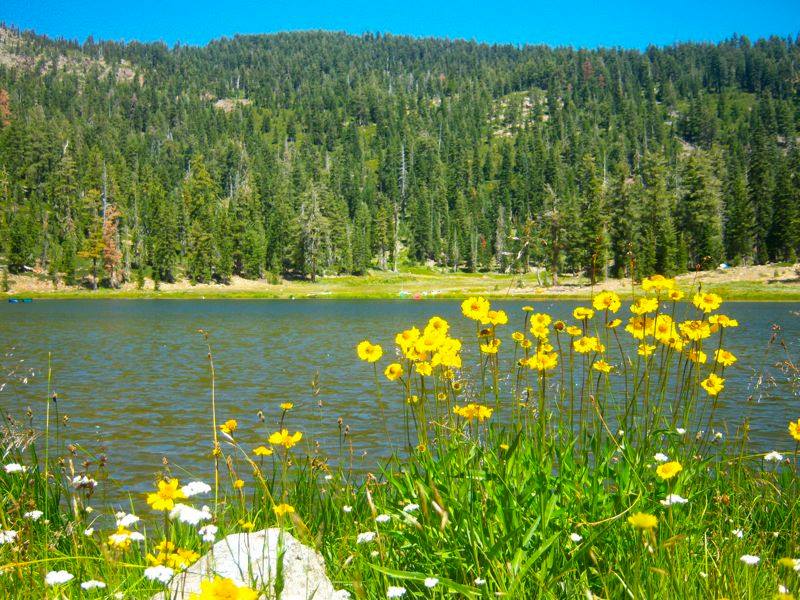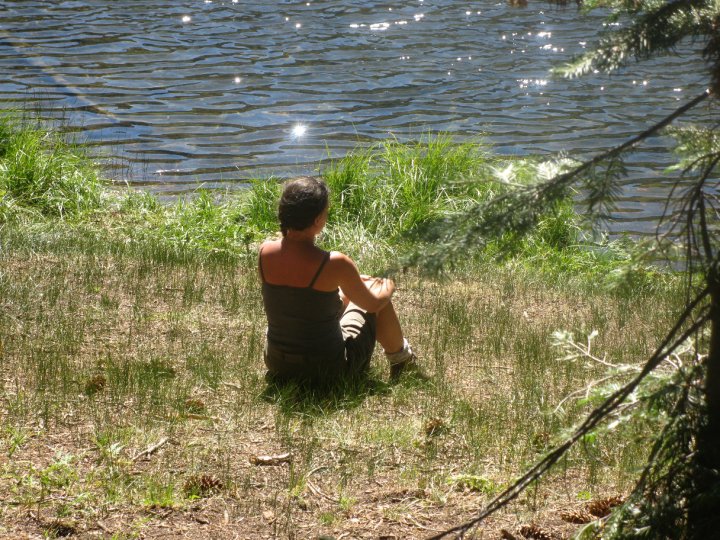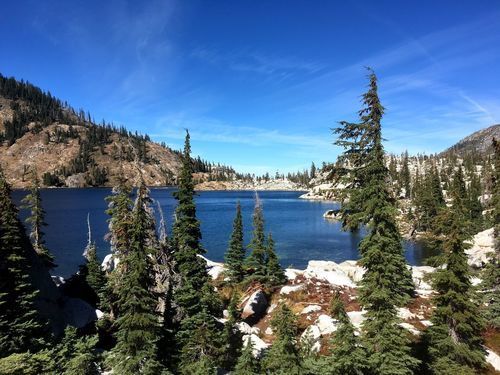
When I was 20 years old, I worked as a counselor at a backpacking camp in California’s Trinity Alps mountains. An East Coast city-girl by birth, I loved camping and hiking and mountains but I’d never seen a peak above 3000 feet, and I’d never set foot in the wilderness. That summer, I was graced with eight glorious weeks of sleeping under the stars, watching the moon move across the night sky, swimming in alpine lakes, and drinking sweet spring water straight from the source. Words cannot do justice to the extraordinary experience of living immersed in such a pristine natural environment. Yet in writing this 25-years later, my body recalls the sensory details with a burst of warm contentment. I can see the glaciers of Mt Shasta reflecting the colors of sunset, hear Chickadee song blend with guitar song, smell the sweet Jeffrey Pine in the cool evening air, and taste, once again, that exquisite water.
Arriving in those mountains for the first time, I felt in my bones that my knowledge and love of the world had instantaneously deepened in a way I’d never previously thought possible. I have only felt that way one other time in my life – the first time I witnessed a baby being born.
Early that summer, amidst the ordinary adventure of backpacking between lakes along the Pacific Crest Trail, came an unexpected excitement. A big mountain storm blew through overnight, and in the morning, high up on the northern ridge, smoke billowed into the air. It was a sight to marvel at, but not to worry about. The trail of smoke was small and distant. It was June in the mountains and patches of snow still dotted the upper basin. The land was damp with recent melt and the fierce rain of the previous evening. The staff went about our breakfast duties humming the Grateful Dead song “Fire on the Mountain” as we worked.
A few hours later, the kids were overjoyed to witness people parachuting down from a helicopter. Smoke jumpers had arrived to put out our fire. Some of the staff hiked up to offer help and sustenance. When the fire was extinguished, the smoke jumpers shared dinner and campfire with us. They regaled the fascinated kids with stories of parachuting into the mountains and fire fighting across the wilderness. This was true adventure, the kid’s eyes seemed to say, real life heroics. They told us that dozens of fires were started by lightning strikes in the Northern Trinities that previous night. When they jumped down into our basin, they had no idea it was occupied.
None of those dozens of fires impacted our summer. Like the one in our basin, they were all quickly extinguished. The Trinities are a land of high granite ridges, alpine peaks and (back then) 8-months of snow cover. Fires came and went with the mountain storms. We continued exploring the beauty of the land, and any little scars we came upon only added to the diversity of color and texture that make up a healthy forest.

I fell in love with the Trinity Alps that summer, and by extension, with the state of California. It was clear that wherever was home to those mountains must also be home to me.
Yet, while I fulfilled my desire to live near the Trinities, my ventures into them have been far less frequent than I intended. The older I got, the more backpacking in the alpine wilderness became something I would “do again soon”. And in recent years, “as soon as my daughter is old enough.” I have always envied the camp staff who never waited for their kids to grow, but packed them into the wilderness on their backs with the gear, and taught them to hike as they learned to walk. Never have I envied them more than now.
It seems so obvious, now, that it was not such a good thing for smoke-jumpers to put out every one of those little fires all over the mountainside. Most of them should have been left to burn, the way lightning sparked fires must have burned in the mountains for millennia, before helicopters and parachutes were invented. Perhaps, if we had been true to the concept of wilderness, and let the land burn and regrow unabated, the drought and heat-fueled megafires now torturing the landscape would have been that much less outrageous. Yet in the 1990s, even those of us who loved that land passionately and protected it fiercely, did not see that we were playing with fire.
The River Complex fires began on July 30th of this year, but I didn’t even know. Despite paying an inordinate amount of attention to air quality across the region. The air in the towns nearest the Trinities had been bad for a while, but given the abundance of fires across central Northern California, that was no surprise. And a fire in the wilderness, even as it burns for months, does not get much press.
Last week, the River Complex took a 6-mile overnight run to the Northeast and threatened a town. I caught sight of the evacuation order on social media. A mere few miles, as the crow flies, from the summer camp’s home basin. The online fire map confirmed that the camp is indeed also at risk, and worse. The map is coated in a huge splotch of red “active fire” that seems to have swallowed the wilderness whole.
The River Complex has burned 36 square miles. That is tiny compared to some of its brethren. The Dixie fire, which exploded that same night, has a 1500 square mile footprint, an area twice the size of New York City. It is truly unfathomably large.
But the Trinity Alps are a small wilderness. And that red spot on the map seems to encompass nearly all of it. Coffee Creek, Caribou Mountain, Granite Lake, Doe Flats, Eagle Peak, the Boulder Lakes… each name sparks memories as rich and embodied as the ones I describe above. Each place a familiar, long lost friend. Now, perhaps, forever lost.
Eco-psychologists and philosophers have coined the term “solastalgia” to define the loss of comfort from a well-loved place, a form of homesickness one gets while still at home, when home has been changed irrevocably by forces beyond our control. It is a disenfranchised grief, unacknowledged by the mainstream, but increasingly common these days. It is, I am sure, being felt by many who live around Lake Tahoe right now, for example. By grace and grit and a lot of hard work, the towns and structures surrounding Tahoe have mostly been saved. But what will the towns become, if the crystal clear lake that once defined them is now muddied with ash, and the surrounding forests reduced to husks?
As a resident of Sonoma County, I have been living this complex grief for years. I have marveled each spring at the new growth sprouting along burnt hillsides. There is a spectacular, unique beauty in the bright greens of fresh ground cover, contrasted against the dark black of burnt tree trunks. But in these drought years, that burst of lively color is followed by an endless dry summer and fall, and the entire once-vibrant landscape seems brown and bleak. From a distance, hillsides appear barren, the blackened skeletons of dead trees haunting the skyline. Up close, old friends – Manzanita, Black Oak, Live Oak, Madrone – stand stark and empty along the trail. They are ghost trees; still upright, yet lifeless. And it hurts every time I see them. I have grown to tolerate it, but the deep sense of connection and solace I once experienced in walking these local forests is gone.
And now the Trinities, my heart home. Even as the future has gotten progressively harder to imagine, I had not given up on the plan to send Dani to camp in the Trinities, as soon as she was old enough to go. How badly I have wanted to share with her the extraordinary sensory wonderland of those mountains. How much I have wanted her to know them and love them as I do.
Tonight I feel debilitated by the weight of the dramatic difference, the stark contrast between the fire dancing on the mountain 25 years ago, and the fire raging through the mountains today. Once again, I am astounded by the indigestible truth: I have always known that within my lifetime we would start to see the consequences of our collective rejection of the planet that sustains us. But this much, this soon? And what does that mean for the future my daughter will experience? How many more well-loved places will we both have to grieve? How many more may she never even be able to know?

Yet I cannot leave these musings on a note of despair. As Robin Wall Kimmerer says in Braiding Sweetgrass, “It is not enough to weep for our lost landscapes; we have to put our hands in the earth to make ourselves whole again. Even a wounded world is feeding us. Even a wounded world is holding us, giving us moments of wonder and joy. I choose joy over despair, not because i have my head in the sand, but because joy is what the earth gives me daily, and I must return the gift”
She is in conversation with Joanna Macy, who teaches in Active Hope that our righteous action is the antidote to despair. She says that action on behalf of life transforms, healing ourselves as we heal the earth. “In rising to the challenge and playing our best role, we discover something precious that both enriches our lives and adds to the healing of the world.”
I have been listening this week to Michael Meade’s talk “Climate Change and Mythic Imagination” in which he puts it this way: “The way out of the chaos is to connect the thread of one’s life into the world… Then we are moving in a way that’s meaningful. And when a human being changes their life, it changes the people around them, and if enough people change their lives it changes the collective. And the next thing you know, you have culture moving back into a dynamic, creative connection with nature.”
Their collective wisdom harmonizes with a yet another source of inspiration, the podcast “How to Save a Planet” in which they encourage us all to find our Climate Superpower – in the intersection between the many things that need doing, the skills we have to offer and that which bring us joy.
The skills I have to offer lie in nurturing and nourishing our young ones. The things that bring me joy are alpine meadows, crystal lakes, sweet flowing springs and the scent of conifers in the fresh mountain air. And so I will continue to weave together my offering for parents and children. That we may all find our way through this time with mindful compassion, integrity and courage. I will promote Regenerative Relationships. For Dani, and for the Trinity Alps.


Leave a Reply